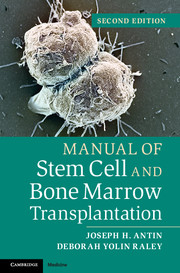Book contents
- Frontmatter
- Contents
- Acknowledgments
- Contributor
- 1 Rationale for transplantation
- 2 Types of transplantation
- 3 Human leukocyte antigen matching in allogeneic transplantation
- 4 Stem cell source
- 5 Pretransplant evaluation and counseling of patient and donor
- 6 Conditioning regimens
- 7 Stem cell infusion
- 8 ABO compatibility
- 9 Engraftment
- 10 Preventative care
- 11 Transplant-related complications
- 12 Overview of acute and chronic graft-versus-host disease
- 13 Acute graft-versus-host disease and staging
- 14 Graft-versus-host disease prophylactic regimens
- 15 Treatment guidelines for acute graft-versus-host disease
- 16 Chronic graft-versus-host disease
- 17 Engraftment syndrome
- 18 Infectious disease
- 19 Graft rejection and failure
- 20 Gastrointestinal complications
- 21 Oral health in stem cell transplantation
- 22 Pulmonary complications
- 23 Veno-occlusive disease
- 24 Special transfusion-related situations
- 25 Cardiovascular complications
- 26 Neurologic complications
- 27 Cystitis
- 28 Donor lymphocyte infusion
- 29 Transplantation: regulation and accreditation
- Index
17 - Engraftment syndrome
Published online by Cambridge University Press: 05 November 2013
- Frontmatter
- Contents
- Acknowledgments
- Contributor
- 1 Rationale for transplantation
- 2 Types of transplantation
- 3 Human leukocyte antigen matching in allogeneic transplantation
- 4 Stem cell source
- 5 Pretransplant evaluation and counseling of patient and donor
- 6 Conditioning regimens
- 7 Stem cell infusion
- 8 ABO compatibility
- 9 Engraftment
- 10 Preventative care
- 11 Transplant-related complications
- 12 Overview of acute and chronic graft-versus-host disease
- 13 Acute graft-versus-host disease and staging
- 14 Graft-versus-host disease prophylactic regimens
- 15 Treatment guidelines for acute graft-versus-host disease
- 16 Chronic graft-versus-host disease
- 17 Engraftment syndrome
- 18 Infectious disease
- 19 Graft rejection and failure
- 20 Gastrointestinal complications
- 21 Oral health in stem cell transplantation
- 22 Pulmonary complications
- 23 Veno-occlusive disease
- 24 Special transfusion-related situations
- 25 Cardiovascular complications
- 26 Neurologic complications
- 27 Cystitis
- 28 Donor lymphocyte infusion
- 29 Transplantation: regulation and accreditation
- Index
Summary
Engraftment syndrome is aninflammatory disorder that usually occurs within the first 2 weeks afterstem cell transplantation.
Clinical manifestations
Clinical manifestations may beassociated with high fevers, generalized erythrodermatous rash, andthird-spacing (explaining peripheral and noncardiogenic pulmonary edema).There may be cough, dyspnea, hypoxemia, multilobar pulmonary infiltrates, orother nonspecific findings.
Diagnosis
Diagnosis is one of exclusion.h ere is no test for it, but tests that may be undertaken to rule outalternative etiologies include cultures, skin biopsy, and bronchoalveolarlavage.
Etiology
Etiology is poorly understood.In general, it is thought to rel ect cytokine production due to immunedysregulation in the context of neutrophil recovery. Polymorphonuclearleukocytes (PMNs) and lymphocytes are thought to be activated and contributeto the injury through further production of inflammatory mediators.
Differential diagnosis
Hyperacute graft-versus-host disease (GVHD) or traditional GVHD.
Infection: Patients should always be treated presumptively for infection while diagnostic studies and cultures are being carried out.
Transfusion-associated lung injury (TRALI). This entity typically occurs proximate to a transfusion and is thought to be due to preformed antiHLA antibodies in the transfused product.
Drug reaction.
- Type
- Chapter
- Information
- Manual of Stem Cell and Bone Marrow Transplantation , pp. 101 - 102Publisher: Cambridge University PressPrint publication year: 2013

